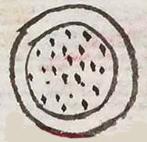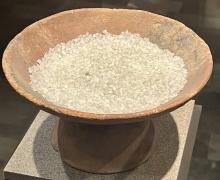iztatl (Mdz13v)
This element has been carved from the compound glyph for the place name, Iztatlan. The main feature is what may be a bowl of salt in a bird's eye view. It is white salt, and the bowl has a rim around it. The center has speckles (grains) that are visible.
Stephanie Wood
The speckles in the salt are reminiscent of those in the glyphs for sand, as seen here: Book of Tributes. The word for salt (iztatl) lent itself to the word for white (iztac), but representations of iztac do not have speckles: https://aztecglyphs.wired-humanities.org/content/iztac. Of course, in some places in the world, salt can be other colors. Balls of salt were tribute items, described for instance in the Book of Tributes published by S. L. Cline (1993), pp. 140–141. The Kingsborough Codex shows a salt glyph with notations amounting to 200; so, 200 balls of salt were to be delivered by a given community as tribute items, along with 80,000 chiles, 800 bundles of beans, and more.
Stephanie Wood
c. 1541, but by 1553 at the latest
Stephanie Wood
salt balls, salt cakes, white
This bowl of salt from Post-Classic Jalisco is housed now in the Museo Nacional de Antropología e Historia, Sala 10. We do not know if the substance in this bowl was called iztatl, but Nahuatl was spoken by some people in Jalisco, so it is possible. This image may suggest that the containers for salt were open circular vessels such as we see here and such as could fit the view of salt in the glyph above. Photo by S. Wood, 30 April 2025.

salt or ball of salt
la sal, la bola de sal
Stephanie Wood
Codex Mendoza, folio 13 verso, https://digital.bodleian.ox.ac.uk/objects/2fea788e-2aa2-4f08-b6d9-648c00..., image 37 of 188.
The Bodleian Libraries, University of Oxford, hold the original manuscript, the MS. Arch. Selden. A. 1. This image is published here under the UK Creative Commons, “Attribution-NonCommercial-ShareAlike 3.0 License” (CC-BY-NC-SA 3.0).



